
4 Strategies for Agile Portfolio Management
Managing a project is often compared to juggling. And that makes sense! It’s all about handling multiple moving objects all at once, keeping everything up and circulating, and trying not to drop anything. At the end there’s a sense of accomplishment and, if you’re lucky, applause!
Many project managers aim to be agile in their project management. They want to be flexible to how projects change over time, and make sure that the end result is the best it can be given current business needs and market conditions.
But what happens when you’re not just managing one project? What happens when you’re juggling two, five, or ten? It becomes an order of magnitude more difficult to keep it all going at once. That’s the struggle of project portfolio management. Now, instead of juggling one set of balls, you’re juggling several sets all at the same time.
And if you want to apply agile methodologies to all your projects at once, you’re in for a big challenge!
Taking an intentional, thoughtful, and highly strategic approach to agile project portfolio management can make all the difference. Here’s four ways to make that approach that can help you keep all the balls in the air, all at once.
Visor makes Jira portfolio management affordable, easy, and collaborative.
Check out how Visor’s pricing compares to Jira‘s portfolio management options.
What does agile project portfolio management mean?
Basically, agile project portfolio management means managing all of your projects at once in a way that still allows for lots of flexibility.
If you’re using agile project portfolios, you’re probably using tools like Jira and Confluence too. Therefore, a lot of our examples and points will center around these types of agile collaboration and project management tools.
Let’s break down what portfolio management is, exactly:
Project portfolio management means that you’re not just managing one project at work – you’re juggling several at once. They might be several projects the same team is working on, projects that different teams (or overlapping combinations of people) are working on, or even massive, organization-wide or cross-organizational projects. These projects all come together to make up your portfolio of work.

Let’s break down what agile is:
Meanwhile, “agile” work comes from “agile methodologies” – the idea that, if you break work down into smaller, time-based chunks, you can work faster and make changes on shorter notice. Being agile in the workplace really just means that you can respond to new challenges and make pivots on the fly. The end result is a body of work that is better adapted to the market you’re in, and doesn’t get as stale or stagnant as long-term planned projects.
Adopting Agile Approach to Your Portfolio:
When you adopt an agile approach to your portfolio, you gain the ability to shift things around, to share resources between different projects, and to get a better sense of the time (and human bandwidth) necessary to pull it all off at once. You’re better able to prioritize tasks and allocate resources as needed, because you’re taking a holistic view of everything at once.
Needless to say, that’s a lot of balls in the air all at once, and project managers need to be extremely nimble in order to juggle them all. That’s why you need to think tactically, and have a highly strategic approach to making it work.
Example of Portfolio of Projects from Jira in Visor:
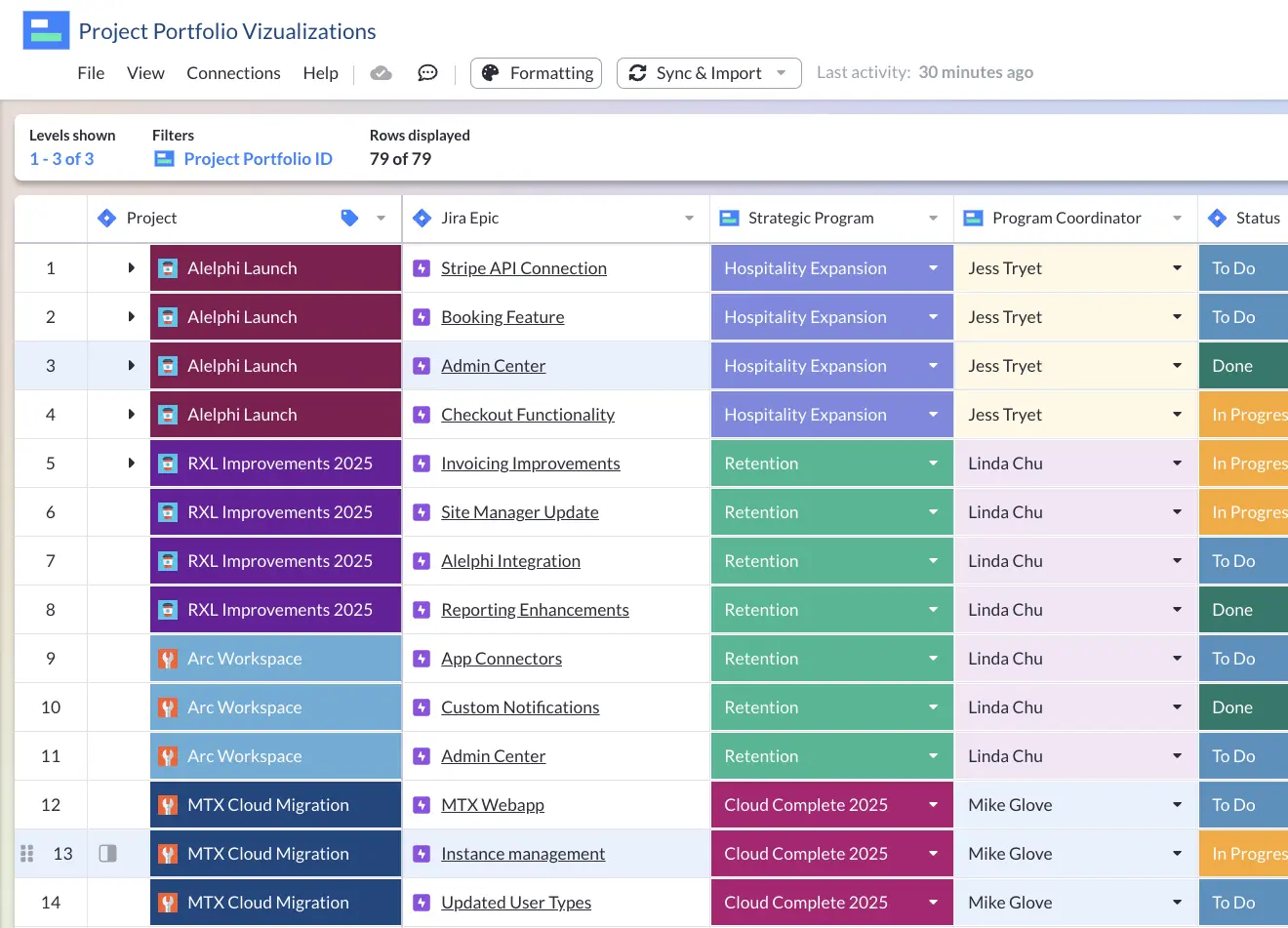
Portfolio management and program management can mean different things. Check out our blog post that unpacks the difference!
Using the Right Agile Project Portfolio Management Tools
Let’s get one thing out of the way first: managing an entire portfolio of projects using agile systems is hard, but if you don’t have the right tools, it’s completely impossible.
Using a tech stack that’s designed to manage multiple projects at the same time isn’t just a nice-to-have – it’s an absolute necessity. For any of the following strategic approaches to work in the first place, you need to have the right tools in place, namely one of the better agile portfolio management tools.
You have a variety of options for this, but make sure that you have certain features in place if you want to use agile strategies.
The first, and possibly the biggest issue, is having a high-level overview that’s still meaningful. Usually this means a great reporting feature or solid dashboards. Features like these will allow you to slice and dice your data and compare details both within and across projects, so that you can make informed decisions.
The best ones allow you to share this information with stakeholders, clients, and team mates, so that they have exactly the information they need – but aren’t overwhelmed with details that aren’t relevant.
Dashboard view in Visor
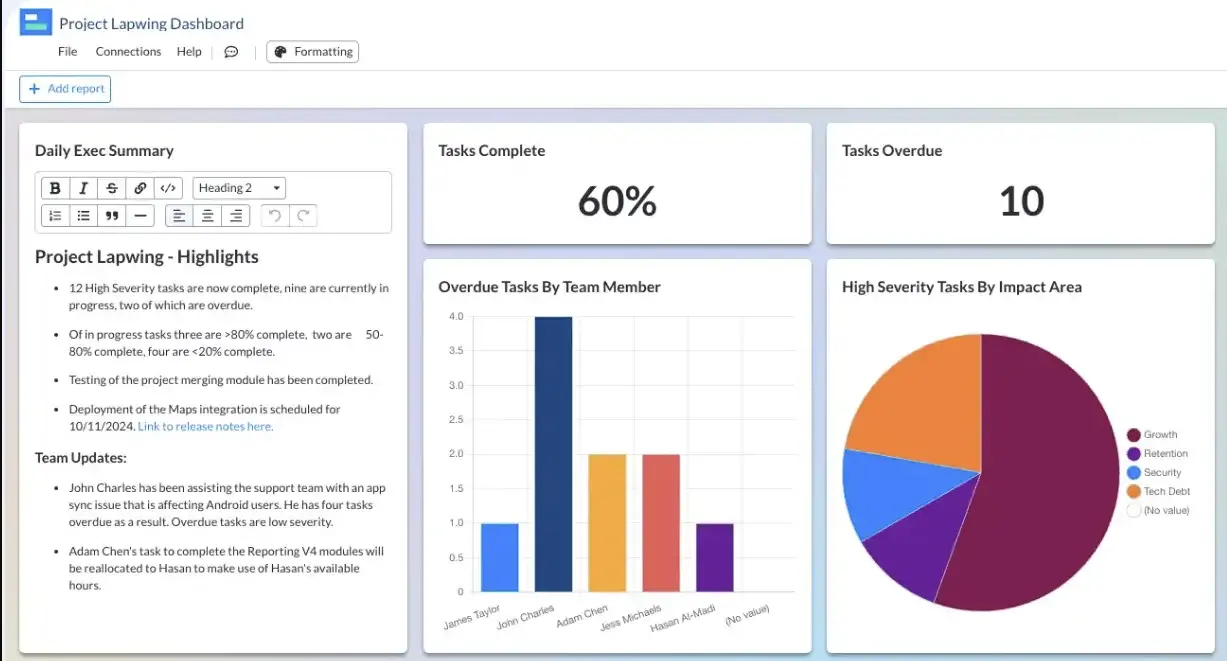
When it comes to managing your projects, agile methodology offers so many different ways to visualize work to be done. A tool that can meet those different needs will help you make the most of agile.
Some teams work best from a kanban board, others from a Gantt chart. Something that allows you to combine multiple projects into one place will offer you significantly more control over what to pivot and when. Ensure any tools you use support that, and learn more about the differences between Kanban boards and Gantt charts and when it’s best to use of each of them.
Agile Gantt chart with Jira data in Visor:
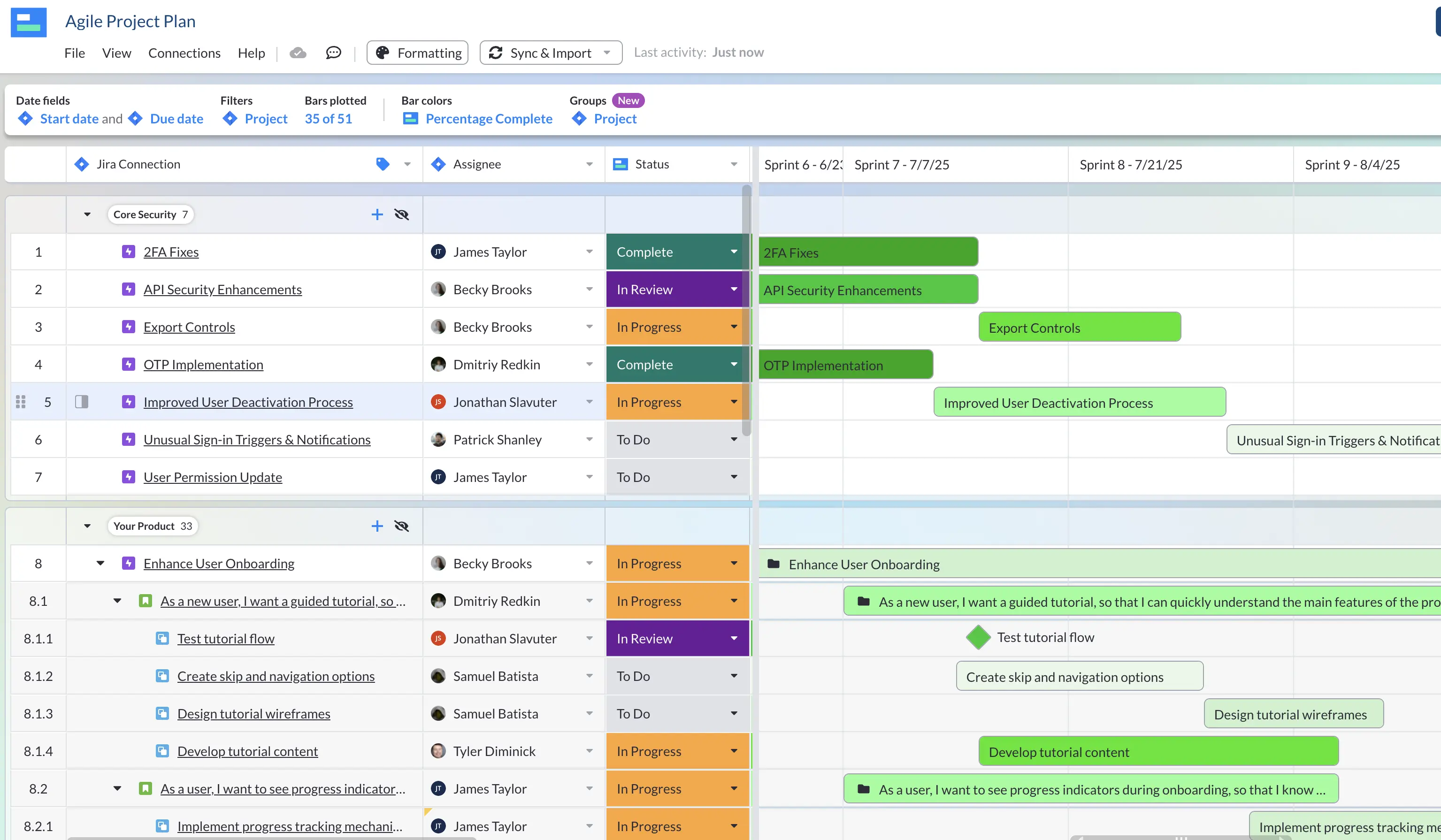
Visor offers Agile Gantt chart templates, Agile roadmap templates, and a host of other templates that give you a jumpstart when creating visualizations across your portfolio of projects.
For successful agile portfolio management, you often need to share granular detail. Some project portfolio management tools nail it on the high level, but that’s it. When you need to drill down into specific details, you’re out of luck. This leads a lot of PMs to rely on old school, manual spreadsheets, which slows everything down substantially.
Spreadsheet Apps & Jira
If you’re using Jira then you can use Google Sheets or an alternative spreadsheet based app to do some portfolio level analysis.
In order to prevent data getting stale you will need to integrate Jira and Google Sheets. Even once you have an integration in place there are substantial limitations, or challenges to using Google Sheets to analyze, monitor, and manage your portfolio.
This leads some Jira users to opt for a spreadsheet-based app that has more inbuilt functionality for project and portfolio management.
Smartsheet and similar apps like Visor that have bi-directional Jira integrations can be used to easily create portfolio roadmaps, dashboards, timelines, spreadsheets, and other views.
Bear in mind that costs can vary wildly here. For example Smartsheet’s Jira Connector is notoriously expensive, with thousands of dollars needed upfront for setup, and then thousands of dollars charged each year on top of your license fees. Visor’s Jira integration is included free, with all plans, including the Visor Free plan.
An agile project portfolio roadmap in Visor, using real-time Jira data:
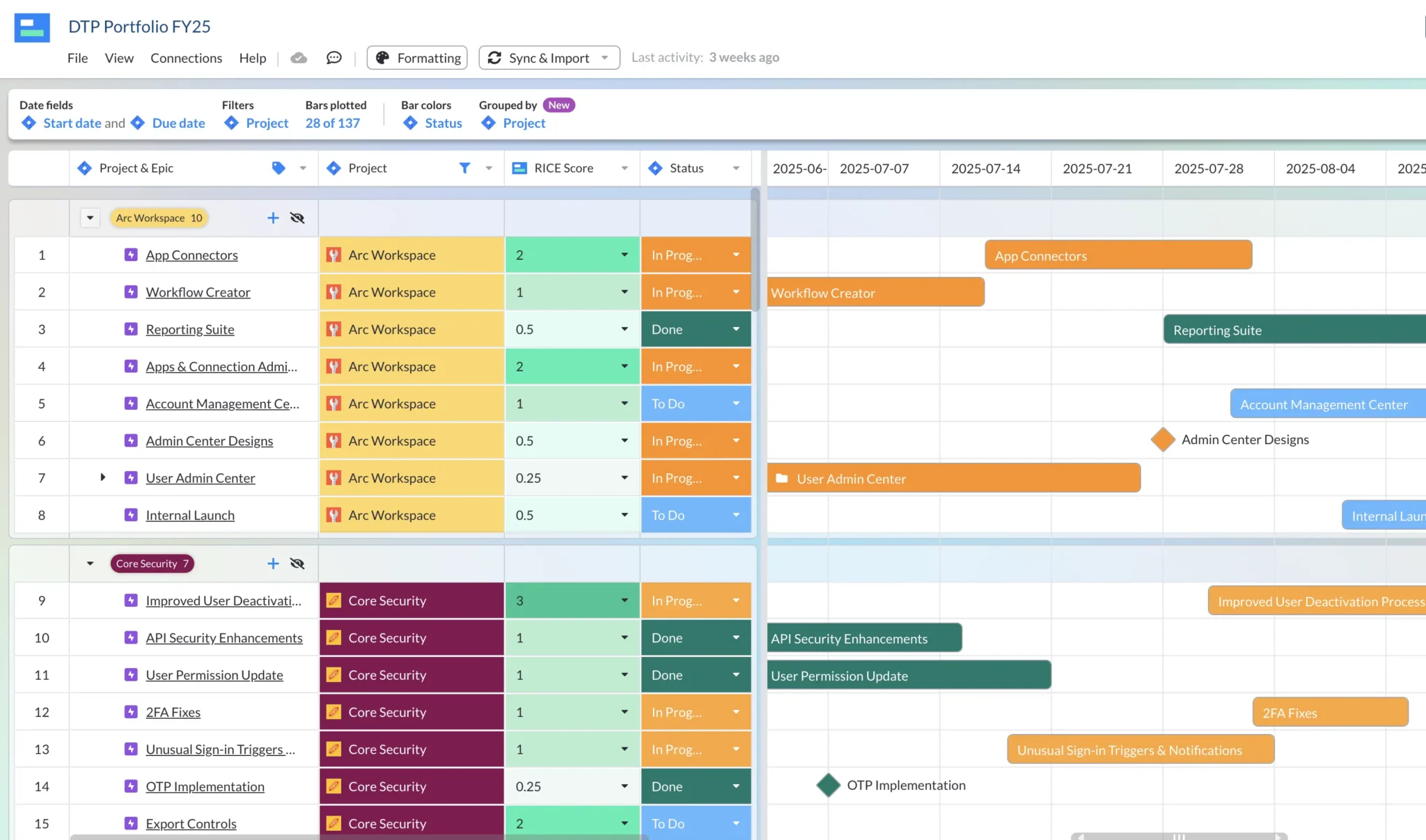
Make sure you can customize how much detail each piece of your project contains, so you’ll have the flexibility to actually manage your project, instead of just looking at it.
Finally, it’s wise to pay attention to the tools your team already uses. If you’re managing multiple projects, you’re almost certainly working with different teams, including a lot of cross-team collaboration. If your marketing team is in Asana but your engineers refuse to leave Jira, it can be extremely challenging to know exactly what’s in motion and what might be stuck.
Look for a project portfolio management solution that integrates with everything your team is already using, so you can get that data into one cohesive place, without trying to force everyone to make big changes to how they work, too.
Visor offers integrations with tools like Asana, Jira, and more:
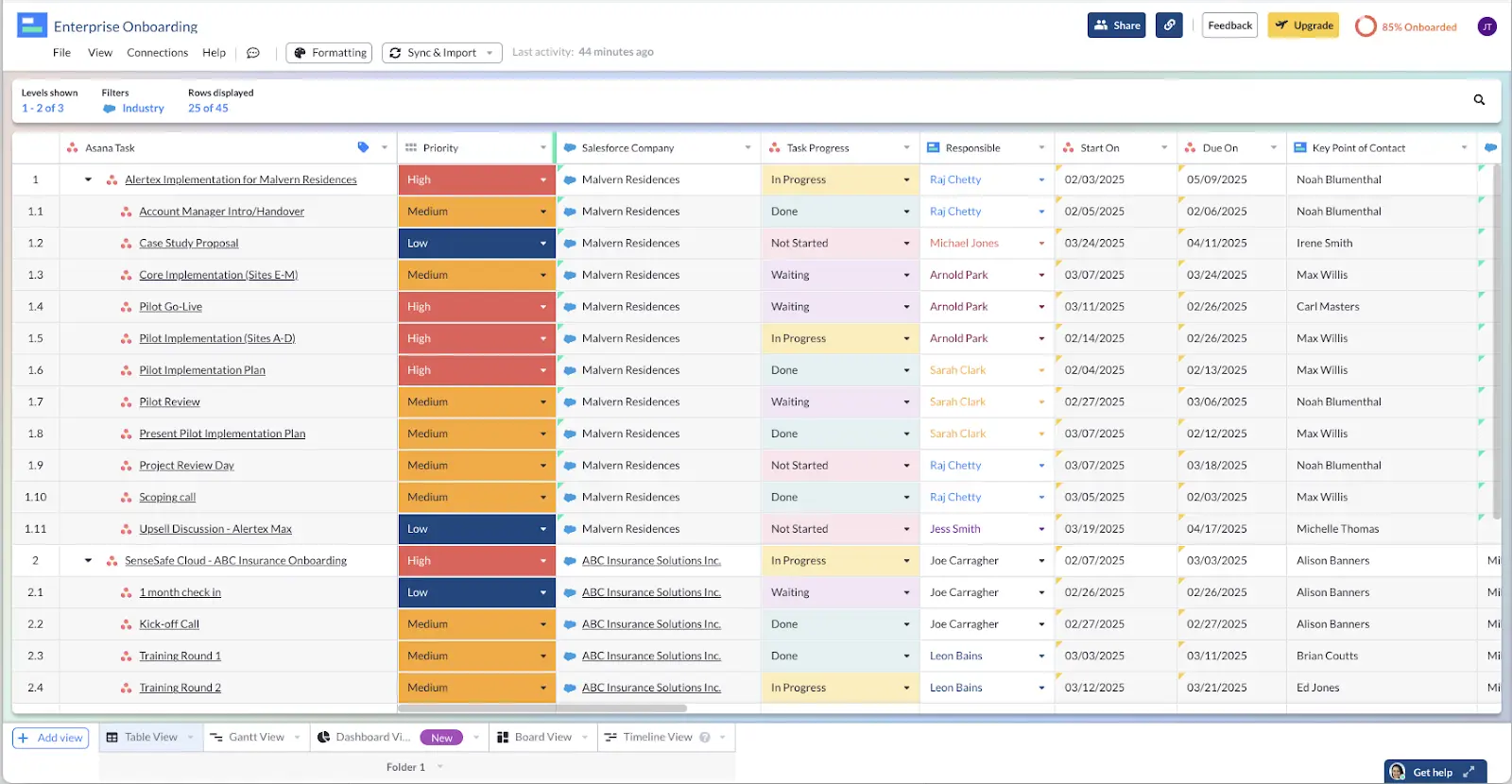
Visor has all of these features – and more! It was built from the ground up with the intention of managing all of your projects, across all the tools your teams already use. Visor provides detailed, granular information that allows you to actively manage projects within it, while still being powerful enough to let you zoom out and look at everything at once. And Visor’s multiple integrations and bi-directional syncing mean that your teams don’t need to change their workflows for you to have deep insight.
It’s free to get started, so give it a shot before trying to implement these strategies. It might just make all the difference.
Strategies for Agile Project Portfolio Management
There are as many strategies for effective agile project portfolio management as there are projects you can manage! But most of the best tactics can be sorted into four big strategic buckets.
Each of these buckets addresses a core aspect of managing a successful portfolio. Some have more to do with aligning on strategic goals, others focus on collaboration, while others are more about using agile principles effectively and intentionally.
Keep in mind that all of these strategies rely heavily on measurement. Great insight into your projects’ metrics and continuous improvement ensures that your entire portfolio stays agile, scalable, and aligned with business needs.
#1: Strategic Alignment and Prioritization
No matter how great your portfolio perspective may be, agile won’t work if only some of the team is using it. Getting in alignment and setting project and portfolio-wide expectations is a critical first strategic step.
Align with Strategic Goals
Ensure all projects and initiatives support strategic objectives. Regularly review and adjust the portfolio to stay aligned with changing business priorities. Visor offers OKR templates and a free OKR tracking template to help you do just that.
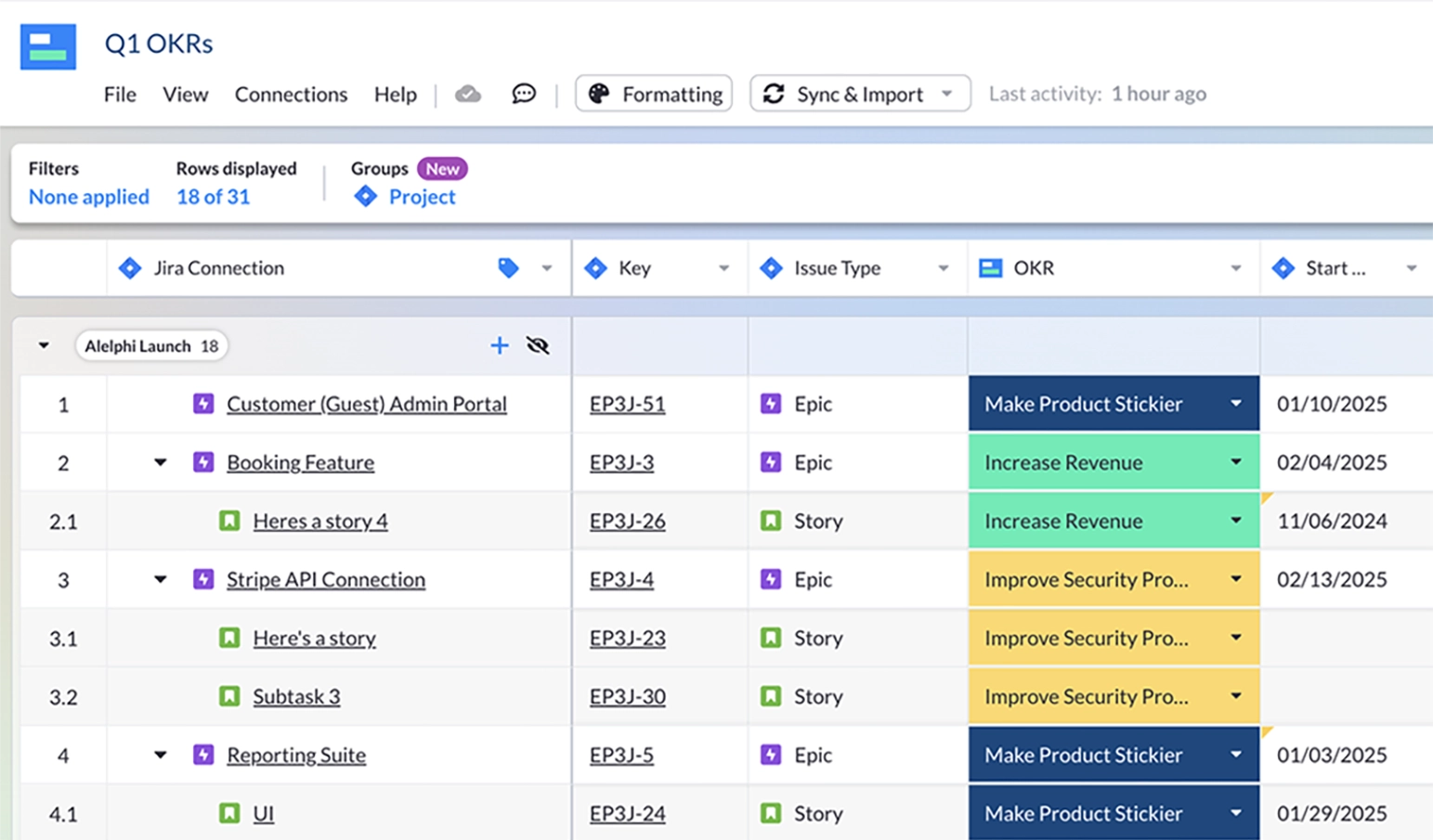
Prioritize Initiatives
Use value-based approaches and regularly reassess priorities based on each project element’s potential impact and alignment with strategic goals. Continuously reassess priorities based on feedback and changing conditions.
Tactics:
- Determine which goals are non-negotiables from the start
- Use agile methodologies for meetings, like stand ups at regular intervals
- Rank project elements using agile estimation techniques
#2: Lean and Agile Project Portfolio Management
Now on to the true meat of agile project portfolio management – the agile part! Keep top of mind at all times that agile is about being highly flexible with your projects, and always willing to pivot. The future of agile relies on its adherents letting go of ego around projects and tasks – for both managers and their teams – and being data-informed at all times.
Implement Lean Portfolio Management
Apply lean principles, minimize waste, and focus on value delivery. Use tools like Kanban board templates to visualize work and manage the flow of projects.
Adopt Incremental Funding
Allocate resources and reassess regularly based on project progress and performance. Allocate resources flexibly to support the most promising and strategically aligned initiatives.
Scale Agile Practices
Implement frameworks like SAFe (Scaled Agile Framework) or LeSS (Large-Scale Scrum) to scale agile practices across the organization. Ensure consistency and alignment of agile practices at all levels.
Tactics:
- Familiarize yourself with agile methodologies that work at scale to make the best calls for each project, and for your full portfolio
- Track key performance indicators (KPIs) such as cycle time, lead time, and team velocity to monitor progress and performance
- Use metrics to make informed decisions about portfolio adjustments – dashboards in systems like Jira help a ton here
#3: Collaboration and Decentralized Decision-Making
Keeping all those project balls in the air and moving means you can’t micromanage or try to control too much. That means your teams need to be empowered to make their own decisions and set priorities for themselves. Pick the right agile collaboration tools to allow you team to drive value and consider these other tips.
Foster Cross-Functional Collaboration
Encourage collaboration between different teams and departments to ensure a holistic approach to portfolio management. Use agile ceremonies like retrospectives at the portfolio level.
Enable Decentralized Decision-Making
Empower teams to make decisions within their scope to increase responsiveness and agility. Establish clear guidelines and boundaries for decision-making authority.
Tactics:
- Get your team on board with making their own priority lists, especially when everyone uses the same methods independently
- Manage your stakeholders just as much as you manage your team
#4: Risk and Dependency Management
Finally, successful agile project portfolio management depends on strategic risk management. Every project has risks, and it’s a mistake not to plan for them. Doing the work to prepare for the worst in advance can only help.
Manage Dependencies and Risks
Identify and manage dependencies between projects to avoid bottlenecks and delays. Proactively identify and mitigate risks that could impact the portfolio’s success.
Visor roadmap with Jira dependencies:
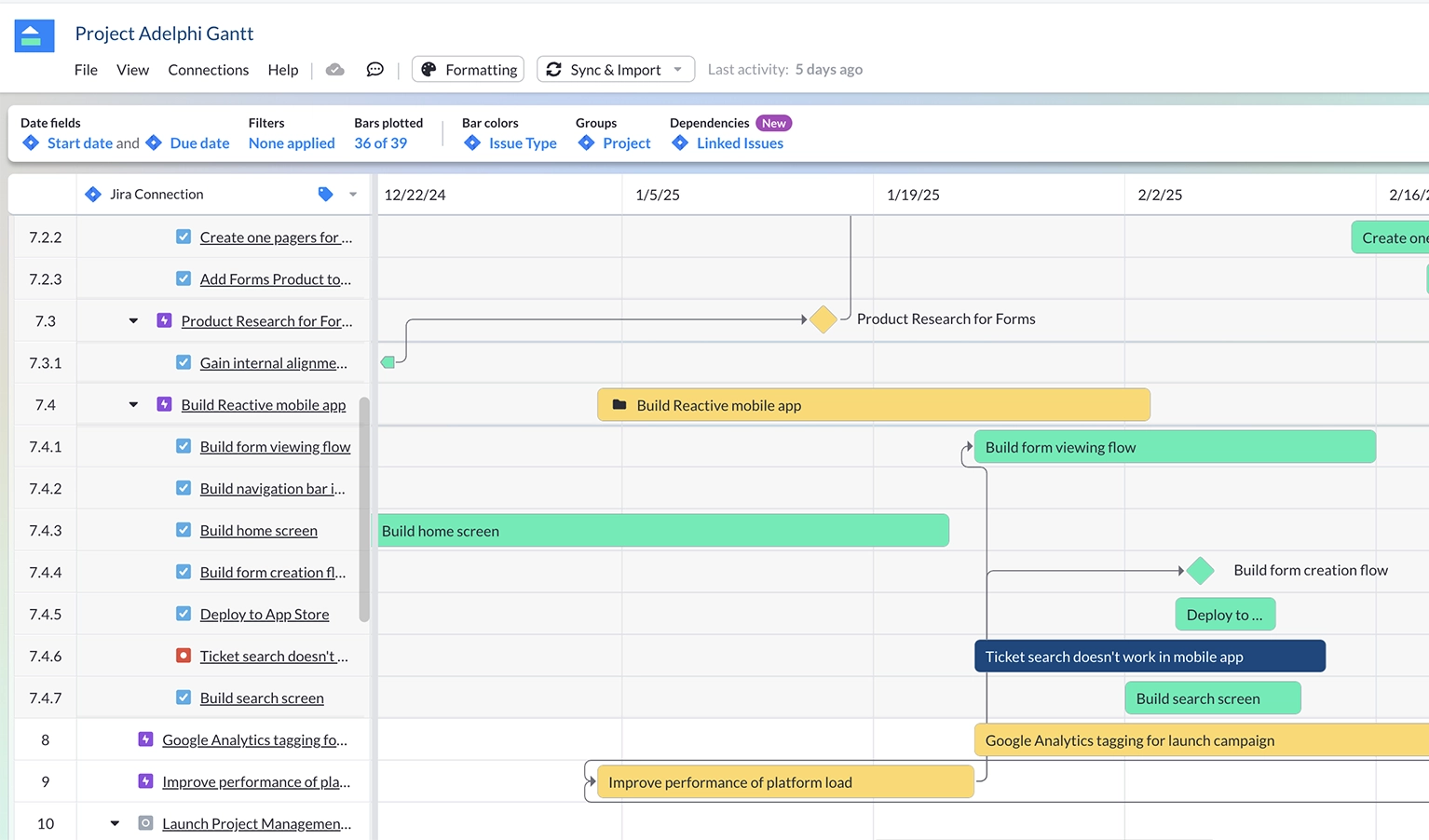
Use Agile Tools and Technology
Leverage agile project management tools like Jira, Asana, and Visor to track and manage the portfolio. Use data and analytics to gain insights and make data-driven decisions.
Tactics:
- Rely on your team’s collaboration tactics to minimize person-created bottlenecks and keep the work flowing
- Use risk assessment methods, like matrixes, to better understand potential problems
- Use great tools like Visor to help visualize data and predict problems before they happen
By implementing these strategies, organizations can effectively manage their project portfolios in an agile manner, ensuring that they deliver maximum value and remain aligned with strategic goals.
How are you managing your project portfolio?
Managing your entire project portfolio at once can feel daunting, but taking an agile approach helps you be more flexible and responsive across every project – helping the end results be even better.
But it’s a big task, and having the right strategic approach makes all the difference.
Visor is here to help. We’re a project portfolio management tool that offers you the highest-level view into all of your projects at once – no matter what tools your team is using!
While we make project portfolio management easy, we also offer templates that make all sorts of visualizations. You can find templates for Mutual Action plans and a customer onboarding template. Because Visor allows you to share your Jira data externally, you can use Visor to offer Jira guest access to stakeholders, clients, and more.
Portfolio Roadmap created in Visor with Jira data:
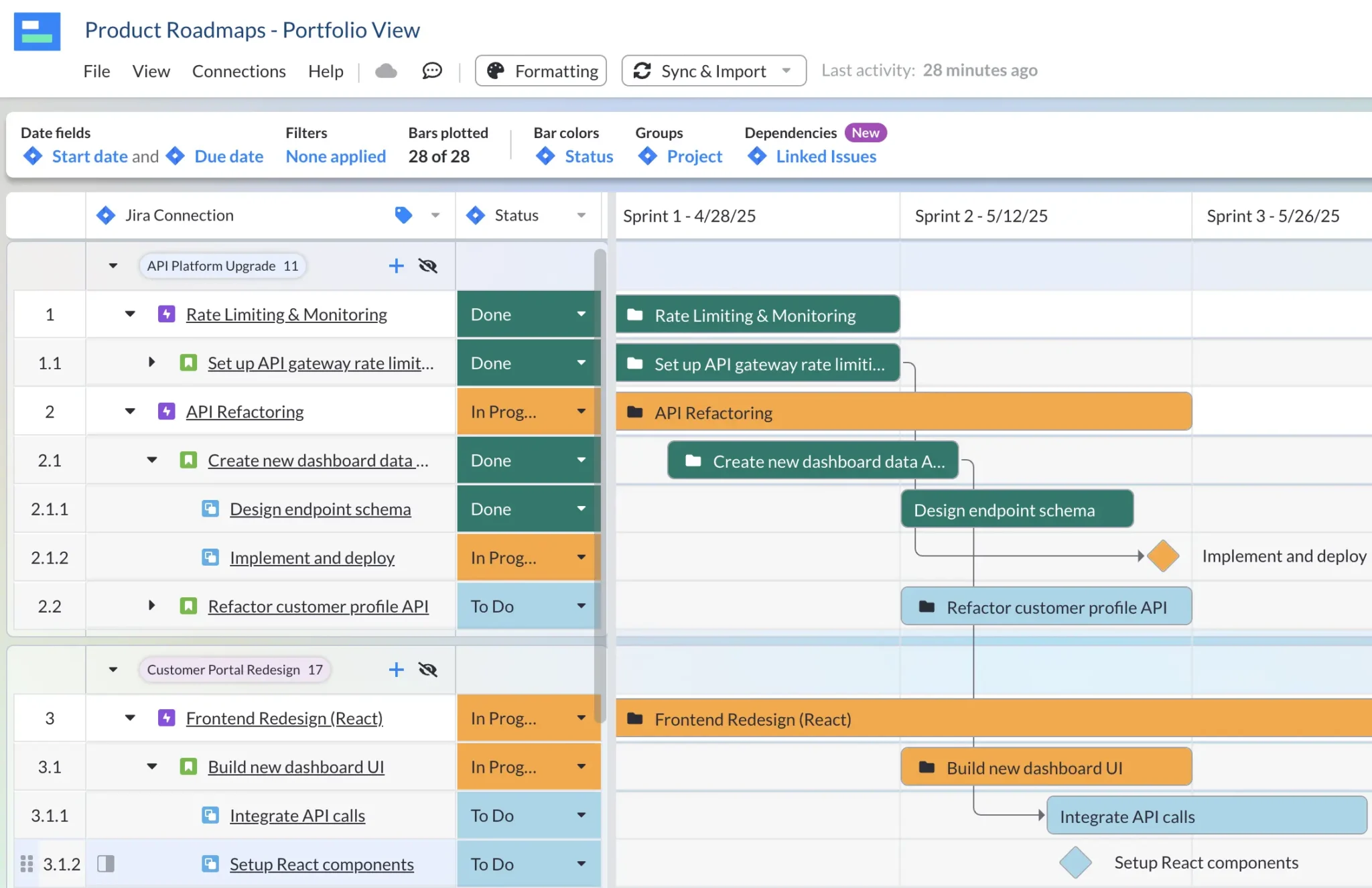
Try it for yourself, free, and find out how much more visibility you could have into managing your portfolio.





